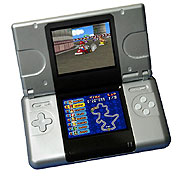LOS ANGELES (CNN/Money) -
Nintendo, facing its stiffest competition to date in the handheld gaming market, has unveiled its latest entry in the field – a dual screened device that embraces its past, yet opens up new avenues for gameplay.
Nintendo is counting on the Nintendo DS to help maintain its lead in the portable market. While it will have games specifically designed for it, the DS will also play any existing (or future) Game Boy Advance titles. The company did not announce a price or give a precise release date, though it did reconfirm the device would be on store shelves in the U.S. and Japan this year. Analysts have suggested the DS will cost anywhere from $149 to $200.
"The DS changes our industry," said Reggie Fils-Aime, executive vice president of sales and marketing for Nintendo of America.

The device is similar in appearance to the GBA sp (the clamshell-like Game Boy introduced last year), but noticeably larger and longer. In addition to its two three-inch color screens (stacked vertically), it also features four buttons, rather than the two found on the GBA.
Designed to appeal to a slightly older audience than Nintendo currently reaches with the GBA, the DS (which will carry a different name when it ships to retail) will also include Wi-Fi wireless capabilities. One of the two screens will also act as a touch-screen, which will be used in conjunction with a stylus or fingertip.
The touch screen and WiFi combination will also let the DS be used for instant messaging nationwide (if used in conjunction with a wireless internet connection).
The same technology allowing users to IM each other will let the DS offer free wireless gaming, letting owners play against each other or co-operatively. Gamers looking to play games can connect with other DS owners within 100 feet without needing any sort of Internet connection.
"It's Nintendo doing what it does best, which is being creative around handheld gaming," said P.J. McNealy, an analyst with American Technology Research. "You'll see some good innovation from Nintendo and other game publishers when the DS hits the market."
Ultimately, it's software that sells a system, and Nintendo plans to launch the DS with some familiar franchises, including a new "Metroid" game, a revised "Mario 64" and "WarioWare," which has been a significant hit for the company on the Game Boy and the GameCube.
Since announcing plans for a new handheld gaming device in January, Nintendo has been fighting whispers that it was planning a successor to the Game Boy Advance. Adding backward compatibility for GBA games may re-ignite those rumors.
"It will push gaming forward, but it's not a quantum leap," said McNealy.
The machine received a rather warm welcome at Nintendo's pre-E3 press conference (which is typically loaded with enthusiastic fans of the company), but when the stylus was mentioned as a gameplay device, those fans let out an audible groan.
Nintendo has long held a dominant position in the handheld gaming space. Since 1989, it has sold more than 168 million Game Boy units and has outlasted several competing products from companies such as Atari, SNK and Sega. The introduction of Sony to the field is seen as Nintendo's stiffest competition to date, however.
The DS will have a headstart of several months in the North American market. In February, Sony quietly delayed the North American launch of the PSP, blaming a lack of software.
Widely seen as a counter to the PSP, the DS will not have the same power as its competitor. While it offers a unique new way to play games, it will only have slightly more processing power than the Nintendo 64 console, which was released eight years ago. Sony, meanwhile, has been touting the PSP as having capabilities that are nearly on par with the PlayStation 2.
Developers and publishers don't seem to mind, though, instead focusing on the possibilities for innovation.
"We look at the Nintendo DS as the next generation of portable gaming," said Brian Ferrell, president of THQ.
The company also said the changes represented in the DS are a hint to what it has in mind for its next home console. Technical specs, argued company president Satoru Iwata, don't matter any more.
"Today's consoles already offer photo-realistic expressions," he said. "By simply beefing up those graphics, most of us will not see a difference. So ...the new machine must do much more. It must offer something no other machine has been able to offer before."
"The next system," he said, "will create a gaming revolution."

|